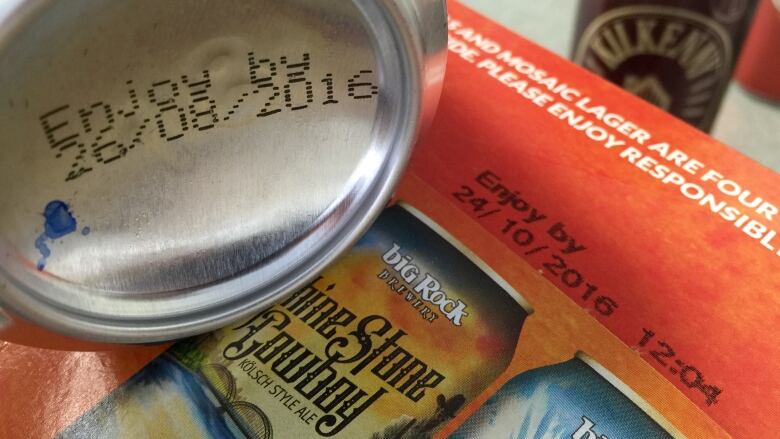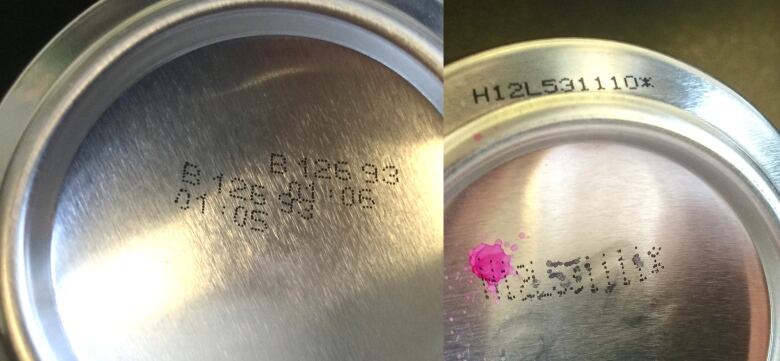Craft brewers want simple best-before dates on beer
Easy-to-read package information could clarify whether it's fresh or getting skunky

If you're cracking open a brew this May long weekend, why not check how fresh itis?
That's the challenge we gaveBrad Goddard, who considers himself pretty savvy when it comes to the date codes on beer. Hehas worked in the beer industry for more than a decade with Big Rock Brewery and Steam Whistle Brewing.
Out of six random beers packagedin a mystery bag purchased at a beer store, his job was to figure out the date stamped on the bottles and cans.
Hecould onlyfigure out half of them.
It should be simple. Most food anddrink items atgrocery stores havebest-before dates that can be found and understood relatively easily.
The product can degrade a little bit. When it goes out the door it is in peak flavour and peak conditionKen Woods, Black Oak Brewing
But beer? Not so much. A lager could be nice and crisp as ifit was picked upstraight from the brewery or itcould be gettingstale having sat in a warehouse and on a store shelf for a few years. You might be able to taste a difference, but good luck finding out its age before you buy the beer and take it home.
All beers carrya date code, but there is no consensuson how to print the date. As well, the code isn't always easy to understand, such as D01C621355 (likely produced on April 1, 2016 at 1:55 p.m.).
- Plenty of campsites left for May long weekend in Manitoba
- 'Aggressive' reservation system in B.C.sparks calls for change
Freshness a hallmark of craft beer
Traditionally, beer drinkers haven't cared too much about how old their beer is because most multinational beer companies pasteurize and filter their product to ensure the taste lasts for a long time.
Customers are starting to be a bit pickier with the rise of craft brewing, inwhich beer often is not pasteurized and is filteredonly lightly, if at all.
These beers don't have as longa shelf life before the taste starts to change, sosome craft brewers are trying to make sure the beer is always fresh. It's important in a ultra-competitive industry where customers have hundreds of beers to choose from.
In the craft segment, freshness is a hallmark, and date coding is the only way consumers can gauge the age.
"It's like a chef making a really good meal," said Ken Woods, owner of Black Oak Brewing in Etobicoke, a suburb of Toronto."When do you want to eat that meal? A couple days from now, a couple months from now or as soon as it's made?"
6 months or 200 days
Pilsenersare most at risk of flavour change if they are not fresh.
Woods saidbeer produced at Black Oakshould ideally be consumed withinsix months or about 200 daysafter it was produced.

The brewery provides a clear label with the production date. Woods wants that to be the industry standard, instead of the various codes that are now allowed.
Woods is a board member ofOntario Craft Brewers, an association thatencourages its members to provide an easy-to-read date on beer. Thegroup also is lobbying theLiquor Control Board of Ontario to simplifybeer date codes.
The issue is so important that Black Oakwill take back beer that hasn'tsold quickly enough.
"The Beer Store is usually pretty good at maintaining code dates. So if there is any old code that comes back we'll turn it into soap or beer jelly," said Woods.
Why so confusing?
The reason behind the often confusing datecodes is notclear, although there are theories.
Goddard, who took our challenge of trying to understand the codes, thinks the big industry players have a lot to do with it.
These main multinationals have set the tone and intentionally made it difficult for consumers to read because it's not a message they wantBrad Goddard, Big Rock Brewery
"Freshness has never been a message for Big Beer, or it hasn't for decades as they've created efficiencies by consolidating production lines. Now it's about efficiency and maximizing shareholder return," said Goddard.
"These main multinationals have set the tone and intentionally made it difficult for consumers to read because it's not a message they want."
While many craft brewers want dates on beer bottles and cans to be clearer, there are some challenges.
There is debate about whether to usea best-before date or a production date.
In addition, brewers will have to expect more beer to be returned by stores, once it's easier for customers to find out how long a 12-pack has satcollecting dust.

Who makes the change?
Domestic and international beer companies have to follow the same rulesif they want to sell their product in Canada. Thepackaging and labels must be in both official languages, show thevolume in metric units and list the alcohol percentage.
A standard date code could be added to the list.
"The government's job is to put the consumer first," said Goddard. "It's an easy ask for them to require it."
In Alberta, the provincial liquor authority does not see the need to mandate a requirement.
"For any discussions on this subject, theAGLC(Alberta Gaming and Liquor Commission)would work with the broader industry, other liquor jurisdictions as well as the federal government (Health Canada, CFIA) to maintain consistency nationally, and more importantly not to be introducing an additional layer of requirements at the provincial level," said AGLC spokeswomanTatjana Laskovic in a statement.
In the meantime, morecraft brewers are voluntarily switching to easy-to-read best-before or production dates.
"Customers will vote with their throats," said Woods."If they think this is a bad beer and they have a bad experience, they may not go back to that brand. We always want it to be fresh and good."
Neither Labatt, Molsonnor the Beer Canada trade association would provide their position on the topic.












_(720p).jpg)


 OFFICIAL HD MUSIC VIDEO.jpg)
.jpg)



























































































